Year 1973, people line up at the movies to watch Magnum Force, The Exorcist, Pat Garret and Billy the Kid, and American Graffiti. Masterpieces such as Pink Floyd's The Dark Side of the Moon begin to play on record players around the world, while in Paris the United States and Vietnam sign the armistice that will end nearly two decades of war. Social and political tensions and increasing violence are setting the stage for a surge of terrorism in much of Europe, with countries such as Italy, Germany and France busy dealing with terrorist groups of different backgrounds and origins, often allied with criminal gangs. In short, these are very interesting and dangerous years, and the birth of the Manurhin MR73 in .357 Magnum caliber should be seen in this light.
MR 73, the swan song for the service revolver
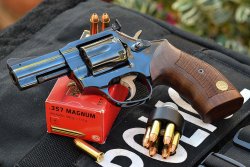
The MR73 revolver was designed by Gilbert Maillard, director of the Manufacture de machines du haut-Rhin (Manurhin) at the request of the French Gendarmerie Nationale, which intended to replace the various semi-automatic pistols the corps had with a single firearm. The most popular models at the time were the Unique R51 in 7.65 Browning (.32 ACP) and the MAC 50 in 9x19. The choice of a revolver for service use in a caliber as exuberant as the .357 Magnum was unusual for a European country and at a time when U.S. police agencies were beginning to abandon revolvers in favor of semi-automatics, but it was reportedly very welcome by the French special corps, first and foremost the GIGN and RAID, which could count on budgets and programs for high-level marksmanship training. Popular and followed in those years in France was Foreign Legion veteran Raymond Sasia, a charismatic shooting instructor and revolver champion who certainly had no small part in the decision. Even Christian Prouteau, the first commander of the GIGN – the Intervention Group of the Gendarmerie Nationale – was convinced that if the operator was perfectly trained in marksmanship and equipped with a quality weapon, the revolver's mere six rounds did not pose much of a problem. Proof in the field came on December 26, 1994, when the GIGN stormed Air France Flight 8969, which had been hijacked in Marseille by GIA (Armed Islamic Group of Algeria) terrorists. Captain Thierry Prungnaud, acting as the lead element, killed two terrorists and wounded a third using his MR73 revolver with a 5 1/2-inch barrel.
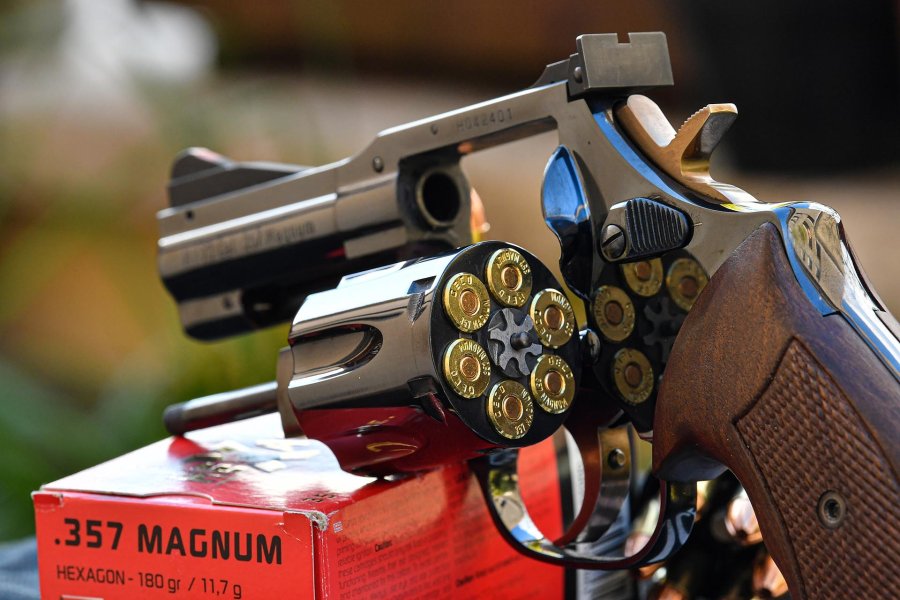
In the late 1980s, however, France too decided to bring the armament of its policemen up to the standards of other countries by adopting a semi-automatic pistol, first a special version of the Beretta 92, later replaced in 2003 by the SIG Sauer 2022, both 9mm semi-automatics. In the late 1990s, all the machines used by Manurhin to make the MR73 revolver were bought by Chapuis, one of the few remaining gun manufacturers in France, which still continues their production in different versions today.
A "custom" revolver for the Gendarmerie
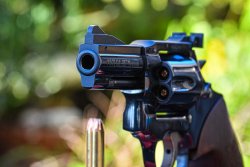
The Manurhin MR 73 is a doubleaction/single-action revolver in .357 Magnum/9x19 caliber inspired by the mechanical scheme of the Smith & Wesson M&P, that is with a leaf hammer spring, but benefiting from some notable improvements. Moreover, the level of hand fitting of the revolver made it about 50 percent more expensive than the competition, but it enabled the user to achieve results unthinkable for a service weapon, both in terms of accuracy and trigger quality.
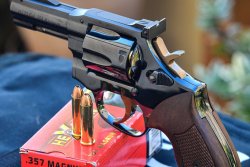
One of the special features of this revolver was the ease with which it could be converted to 9mm Luger caliber by replacing the cylinder, a peculiarity restricted to law enforcement models. The conversion was based on a patent by Maillard himself, which provided for a C-spring for each cylinder chamber that engaged the rim of the 9mm Luger cartridge, keeping it in the correct position and allowing it to be ejected simultaneously by means of a specially modified extractor star. In Maillard's design, in fact, the slide that controls the double-action trigger rebound is operated by a leaf spring independent from the hammer spring. The slide itself slides on a pair of rollers that make the double-action incredibly smooth. The system also allows the trigger weight to be adjusted without affecting the energy of the hammer spring, thus without affecting the revolver reliability. Another advantage of Maillard's design that has beneficial effects on accuracy and rate of fire is the reduction in lock time. The MR73 has in fact a hammer drop angle of only 42 degrees, compared to 54 degrees in S&W revolvers and 60 degrees in the Colt Python.
That's not all: Maillard's modifications not only didn't compromise frame strength, but allowed it to be even sturdier than its competitors. Combine this with top-notch materials and finishes, and we are looking at one of the best and most rugged .357 Magnum revolvers ever made.
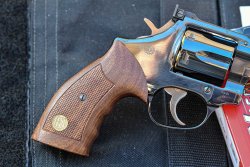
The Manurhin MR 73 revolver was manufactured in several self-defense and targer shooting versions, with barrel lengths of 2.5", 3", 4", 5 ¼", 5 ¾", 6", 8", 10 ¾" also in .22 Long Rifle, .32 Long and .38 Special calibers. In all models the barrel is pinnet to the frame. Sights could be of two types: fixed, with a notch milled directly into the frame and a front sight integral to the barrel rib, or with an adjustable rear notch and a ramped front sight pinned to the barrel, like the one you see in the photos. The rear sight of the sport shooting models, referred to as "Match," was set back about 2 centimeters from the frame so as to further lengthen the sight radius, while the sights were interchangeable with different profile models. Following the fashion of the time, the barrel has a wide upper rib and full underlug that completely surrounds the extractor rod. In addition to making the weapon very aesthetically attractive, the extra weight helps to reduce muzzle flip. The grips could be walnut wood or rubber with a semi-anatomic profile, and a compartment inside them holds the Allen key that is used to adjust the trigger assembly. The frame is superbly blued, while the interior surfaces are satin-finished – a finesse of yesteryear. Hammer and trigger feature a high-resistance bronzed finish that protects from corrosion these two parts, frequently in contact with the operator's fingers.
A special version of the model with an eight-inch barrel, fitted with a bipod and a long-focus scope mounted on the rib, was adopted by the GIGN as a weapon for precision shooting at short to medium distances.


The Manurhin MR73 on the range
Let's now turn the floor over to our colleague Franco Palamaro, who had a chance to try a beautiful GIGN version of the Manurhin MR73. From here on, the telling voice is his.
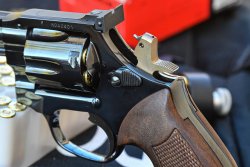
"I had the pleasure of trying a vintage MR73 revolver on the range, in the GIGN version with a 3-inch barrel, adjustable sights and walnut grips. The Manurhin MR73 feels perfect in your hand, is very balanced, ergonomically excellent, in the two-handed grip it naturally aligns with the target, with a remarkable instinctiveness, as if I had always used this revolver. Cylinder loading and unloading operations are very fast, thanks in part to the speedloaders – you can use speedloaders normally used for K-frame S&Ws – with the cylinder release perfect in size and feedback.
When shooting, the MR73 behaves nervously, undoubtedly because of the really short barrel. Recoil is sharp, not annoying with the ammunition tested (the loading is not full power, these are shooting cartridges designed for maximum accuracy as well as the best comfort and least fatigue in training sessions), but still less mild than with guns featuring a 6" barrel; the short sight radius still allows a high level of accuracy thanks to the great quality of construction of the adjustable rear notch and the front sight.
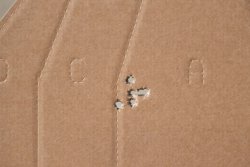
The trigger is nothing short of magnificent in double action, very smooth and with a well-predictable release, however safe because of the high pull weight – this is a gun that implies professional use – while in single action it feels like a sports shooting rifle trigger, considering how pleasant and crisp it is, with the classic "glass break" feel.
Shooting accuracy is unparalleled, at 25m with GECO shooting cartridges in .357 Magnum, 180-grain Hexagon bullet, a 38 mm group (excluding bullet diameter) speaks for itself.
Spent brass is perfect, no burn marks, clean and intact, with such a centered percussion that it looks like it was made on a lathe.”
Manurhin MR73: wrapping up
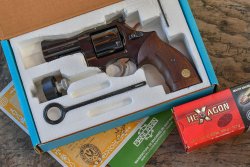
The Manurhin MR73 is considered one of the best modern revolvers, and in our opinion this reputation is well deserved, both for the quality of construction and for its shooting performance. Even in the three-inch barrel version, accuracy is astounding. We have to give Gilbert Maillard credit for having succeeded in improving an already excellent basic design by creating a memorable weapon; an even more interesting achievement if we consider that in the 1970s France had no recent experience in revolver manufacturing, since the last such firearm to be produced by a French factory was the 1892 model in 8mm Lebel caliber, which although it looks prehistoric compared to the MR73 was nevertheless the first service revolver with a side swinging cylinder. Our advice is: if you find a Manurhin MR73 in good condition on the used market, buy it.
Manurhin MR73 GIGN .357 Magnum specs
| Model: | Manurhin MR73 GIGN |
| Caliber: | .357
Magnum |
| Cylinder
Capacity: | 6 rounds |
| Action: | Double-action/single-action |
| Sights: | Front fixed, rear adjustable |
| Barrel
Length: | 3”/76 mm |
| Materials: | Carbon steel frame and barrel |
| Grip: | Walnut wood |
| Price: | No longer
produced, can be found on the used market |










